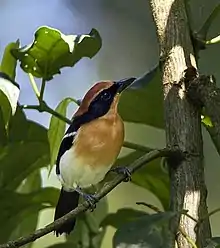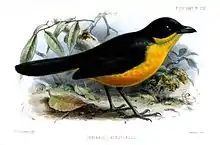| Laniarus | |
|---|---|
 | |
| Yellow-crowned gonolek Laniarius barbarus | |
| Scientific classification | |
| Domain: | Eukaryota |
| Kingdom: | Animalia |
| Phylum: | Chordata |
| Class: | Aves |
| Order: | Passeriformes |
| Family: | Malaconotidae |
| Genus: | Laniarius Vieillot, 1816 |
| Type species | |
| Lanius barbarus Linnaeus, 1766 | |
| Species | |
|
see text | |
Laniarius is a genus of brightly coloured, carnivorous passerine birds commonly known as boubous or gonoleks. Not to be confused with the similar-sounding genus Lanius, they were formerly classed with the true shrikes in the family Laniidae, but they and related genera are now considered sufficiently distinctive to be separated from that group as the bush-shrike family Malaconotidae.
This is an African group of species which are found in scrub or open woodland. They are similar in habits to shrikes, hunting insects and other small prey from a perch on a bush. Although similar in build to the shrikes, these tend to be either colourful species or largely black. Some species are also quite secretive.
Taxonomy and systematics
The genus Laniarius was introduced by the French ornithologist Louis Pierre Vieillot in 1816 to accommodate a single species, the yellow-crowned gonolek, which is therefore the type species.[1][2]
The closest relatives of the genus appear to be the genus Chlorophoneus. Previously, members of the genus Laniarius had been classified on the basis of plumage. However, a 2008 molecular study found that the species had developed different colours and patterns in plumage independently and similar-coloured species were often unrelated. The authors hypothesized that the ancestor of the genus may have been dark-coloured.[3]
There are 22 recognised species:[4]
| Image | Common Name | Scientific name | Distribution |
|---|---|---|---|
| Lowland sooty boubou | Laniarius leucorhynchus | Angola, Benin, Cameroon, Central African Republic, Republic of the Congo, Democratic Republic of the Congo, Ivory Coast, Equatorial Guinea, Gabon, Ghana, Guinea, Guinea-Bissau, Liberia, Nigeria, Sierra Leone, South Sudan, Togo, and Uganda. | |
| Mountain sooty boubou | Laniarius poensis | Nigeria, Bioko; Rwanda, Burundi and adjacent areas of Uganda and Democratic Republic of the Congo. | |
| Albertine sooty boubou | Laniarius holomelas | Uganda and Democratic Republic of the Congo. | |
| Willard’s sooty boubou | Laniarius willardi | Burundi and Uganda | |
| Fuelleborn's boubou | Laniarius fuelleborni | Malawi, Tanzania, and Zambia | |
 | Slate-colored boubou | Laniarius funebris | Ethiopia, Kenya, Rwanda, Somalia, South Sudan, Tanzania, and Uganda. |
 | Lühder's bushshrike | Laniarius luehderi | Angola, Burundi, Cameroon, Republic of the Congo, Democratic Republic of the Congo, Equatorial Guinea, Gabon, Kenya, Nigeria, Rwanda, South Sudan, Tanzania, and Uganda. |
| Braun's bushshrike | Laniarius brauni | Angola | |
| Gabela bushshrike | Laniarius amboimensis | Angola. | |
| Red-naped bushshrike | Laniarius ruficeps | Ethiopia, Kenya, and Somalia | |
| Black boubou | Laniarius nigerrimus | Somalia and northern Kenya. | |
| Ethiopian boubou | Laniarius aethiopicus | Eritrea, Ethiopia, northwest Somalia, and northern Kenya. | |
.jpg.webp) | Tropical boubou | Laniarius major | sub-Saharan Africa |
| East Coast boubou | Laniarius sublacteus | southeast Somalia to northeast Tanzania, and Zanzibar island. | |
.jpg.webp) | Southern boubou | Laniarius ferrugineus | southeastern Zimbabwe, eastern Botswana, Mozambique and southern and eastern South Africa |
| Swamp boubou | Laniarius bicolor | Angola, Botswana, Cameroon, Republic of the Congo, DRC, Gabon, Namibia, Zambia, and Zimbabwe. | |
| Turati's boubou | Laniarius turatii | Guinea, Guinea-Bissau, and Sierra Leone | |
.jpg.webp) | Yellow-crowned gonolek | Laniarius barbarus | Senegal and Democratic Republic of Congo east to Ethiopia. |
_-_Kibale_National_Park%252C_Uganda.jpg.webp) | Papyrus gonolek | Laniarius mufumbiri | Burundi, Democratic Republic of the Congo, Kenya, Rwanda, Tanzania, and Uganda |
 | Black-headed gonolek | Laniarius erythrogaster | Burundi, Cameroon, Central African Republic, Chad, Democratic Republic of the Congo, Eritrea, Ethiopia, Kenya, Nigeria, Rwanda, Sudan, Tanzania, and Uganda. |
.jpg.webp) | Crimson-breasted shrike | Laniarius atrococcineus | southern Angola to the Free State province in South Africa. |
 | Yellow-breasted boubou | Laniarius atroflavus | western Cameroon and adjacent southeastern Nigeria |
Formerly, some authorities also considered the following species (or subspecies) as species within the genus Laniarius:
- Rufous whistler (as Laniarius rubrigaster)[5]
References
- ↑ Vieillot, Louis Pierre (1816). Analyse d'une Nouvelle Ornithologie Élémentaire (in French). Paris: Deterville/self. p. 41.
- ↑ Mayr, Ernst; Greenway, James C. Jr, eds. (1960). Check-List of Birds of the World. Vol. 9. Cambridge, Massachusetts: Museum of Comparative Zoology. p. 326.
- ↑ Nguembock, Billy; Fjeldså, Jon; Couloux, Arnaud; Pasquet, Eric (2008). "Phylogeny of Laniarius: molecular data reveal L. liberatus synonymous with L. erlangeri and "plumage coloration" as unreliable morphological characters for defining species and species groups". Molecular Phylogenetics and Evolution. 48 (2): 396–407. doi:10.1016/j.ympev.2008.04.014. PMID 18514549.
- ↑ Gill, Frank; Donsker, David; Rasmussen, Pamela, eds. (January 2023). "Batises, woodshrikes, bushshrikes, vangas". IOC World Bird List Version 13.1. International Ornithologists' Union. Retrieved 25 March 2023.
- ↑ Australia, Atlas of Living. "Pachycephala (Alisterornis) rufiventris rufiventris | Atlas of Living Australia". bie.ala.org.au. Retrieved 2017-02-06.